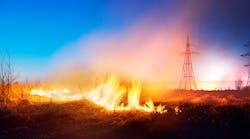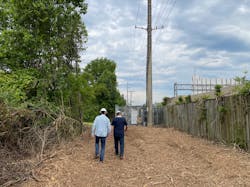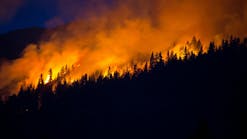Just a single spark can ignite a wildfire in an electric utility’s service territory. Flames can then rapidly spread across the landscape, incinerating infrastructure and inflicting costly damage to a utility’s system.
With climate change leading to more erratic weather patterns, many parts of the world are experiencing hot and dry conditions, which elevates the risk of wildfires. Many companies are trying to take a proactive — rather than a preventive — approach to wildfire mitigation, but challenges remain.
Fortunately, technologies and innovations are now available to help utilities not just respond to wildfires, but instead, stop them from ever starting.
Stopping the sparkWhile there are many different factors that contribute to wildfires, when investigating their causes, in some cases, electrical equipment failure has been discovered as one of the possible sources of the initial spark. In several instance, wildfires in both Australia and California have been linked to electrical equipment.
For years, utilities have installed surge arresters on power lines to protect electrical equipment. When the line experiences a current overload, the arrester sacrifices itself to protect the downstream equipment. The problem, however, is that thermally overloaded surge arresters installed on power lines in dry areas can cause arcing, and potentially throw off hot sparks, which can ignite the grassland and vegetation down below.
“With strong winds interacting with vegetation and drier conditions becoming more prevalent, a single spark can very easily fall into the wrong location,” says Helena Garriga, Head of Global Product Group Power & Industry Components at Hitachi Energy. “Vegetation management was already a primary area of investment for utilities. This goes to the next level. Rather than just mitigating the impact of the spark, we are avoiding the spark altogether.”
To create a more climate-resilient network, Hitachi Energy launched the Spark Prevention Unit (SPU). Today, line crews can install surge arresters and SPUs simultaneously on distribution lines in areas with the highest risk of wildfires.
Currently, Hitachi Energy has hundreds of thousands of these units installed around the world — from wildfire-prone areas in California to remote regions in Australia. Oftentimes, utilities install the SPUs in areas spanning thousands of miles.
The SPU monitors the electrical current and thermal load of the surge arrester. If it senses a thermal overload — which could cause sparking and a subsequent wildfire — it disconnects it from the rest of the network. A tube-shaped red visual indicator then pops out, demonstrating the need for replacement.
To expedite maintenance and unit replacement, Hitachi Energy recently digitalized the SPU to offer wireless connectivity. The new wireless indicator transmits the SPU’s real-time status through long-range wireless communication. Utilities can then pinpoint the exact GPS location of the disconnected surge arrester, saving time and resources. Rather than sending crews to patrol the power lines and search for red visual indicators, a utility now knows exactly when and where an SPU has been triggered. The company can then send a crew to a particular location to replace the unit, thereby avoiding risks of major failures and unplanned outages. This can also help them target investigations into the cause of thermal overloads and seek ways to mitigate them in the future.
Hitachi Vegetation Manager is a highly scalable and intuitive application that leverages artificial intelligence and advanced analytics to improve the accuracy and effectiveness of an organization’s vegetation management and planning efforts.
Managing Vegetation-Related Risks
For electric utilities, wildfires are caused not only by equipment but also power line contact with foreign objects, such as vegetation. While utilities often focus on hazard trees, which can potentially fall on power lines, the majority of interruptions and wildfires in high-sustained wind events come from healthy trees—almost all of which are undetectable with human judgement.
Climate change has also altered vegetation risk profiles, leading to more precipitation, longer growing seasons and more severe storms, says Jeff Pauska, Vegetation Manager Product Director at Hitachi Energy.
“There’s now a greater need for visibility because vegetation is growing back faster,” Pauska says. “You have to put eyes on the target.”
When managing growing vegetation, utilities are facing multiple challenges at once. For example, some utilities are still handling inspections by walking the power lines with paper maps while others are relying upon disconnected data and siloed systems. Utilities are also increasingly using LiDAR scans, satellite data or drone imagery, but they may only be using this technology on high-voltage lines on an infrequent basis.
Compounding the challenge, utilities are now facing a constraint on resources due to the contractor shortage. To do more with less, utilities are prioritizing mission-critical work and automating low-value, time-consuming vegetation management activities.
To gain visibility into their entire vegetation network and further gain efficiencies, utilities can leverage Hitachi Vegetation Manager, a closed-loop resilience system, which includes two native iOS field apps and a web-based back-office application. Data from drones, LiDAR, satellites, and other visual input is analyzed using artificial intelligence and then presented in a single-pane-of-glass view.
In addition, utilities can extract insights from arborists, foresters, and crew leaders about where wildfire risks are observed, the type of fuel loading that exists, and other environmental considerations that contribute to risk in their service territory. By overlaying geospatial intelligence on top of digitalized human knowledge about wildfire risks and mitigation, utilities can treat each area of the grid with a specific maintenance plan and strategy.
“The folks in the field know the territory like the back of their hand, so digitalizing that human knowledge and bringing it into the back office can help with decision-making and maintenance planning,” Pauska says. “The most valuable data you have at a utility is human insight.”
The Vegetation Manager software delivers three main customer benefits. First, it serves as a single source of truth by housing data from all the sources to enhance planning outcomes. Secondly, it focuses on forecasting and deep learning to identify current and future hazards hidden from traditional inspection methods. Finally, it simulates and suggests maintenance strategies for long-term resilience and prevention of unforeseen catastrophic events.
“It’s a full circle of understanding not only where fires could potentially occur, but also the magnitude, impact and consequences of those fires to prioritize maintenance schedules using all relevant data together in an effective way,” Pauska says. “Everything comes together to drive greater insights about the work that is happening. The foundation for utilities to reduce business risk starts and ends with planning.”
For more information about Hitachi Energy’s technology for wildfire mitigation, visit our Spark Prevention Unit and Vegetation Manager websites.
Sponsored by:





